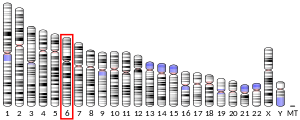RIPOR2
RHO family interacting cell polarization regulator 2 is a protein that in humans is encoded by the RIPOR2 gene.[5]
Function
The protein encoded by this gene stimulates the formation of a non-mitotic multinucleate syncytium from proliferative cytotrophoblasts during trophoblast differentiation. Alternative splicing of this gene results in multiple transcript variants. [provided by RefSeq, Nov 2013].
Clinical significance
Mutations in RIPOR2 are associated to hearing loss.[6]
References
- GRCh38: Ensembl release 89: ENSG00000111913 - Ensembl, May 2017
- GRCm38: Ensembl release 89: ENSMUSG00000036006 - Ensembl, May 2017
- "Human PubMed Reference:". National Center for Biotechnology Information, U.S. National Library of Medicine.
- "Mouse PubMed Reference:". National Center for Biotechnology Information, U.S. National Library of Medicine.
- "Entrez Gene: Family with sequence similarity 65, member B".
- Diaz-Horta O, Subasioglu-Uzak A, Grati M, DeSmidt A, Foster J, Cao L, Bademci G, Tokgoz-Yilmaz S, Duman D, Cengiz FB, Abad C, Mittal R, Blanton S, Liu XZ, Farooq A, Walz K, Lu Z, Tekin M (July 2014). "FAM65B is a membrane-associated protein of hair cell stereocilia required for hearing". Proceedings of the National Academy of Sciences of the United States of America. 111 (27): 9864–8. doi:10.1073/pnas.1401950111. PMC 4103326. PMID 24958875.
Further reading
- Morrish DW, Dakour J, Li H (September 2001). "Life and death in the placenta: new peptides and genes regulating human syncytiotrophoblast and extravillous cytotrophoblast lineage formation and renewal". Current Protein & Peptide Science. 2 (3): 245–59. doi:10.2174/1389203013381116. PMID 12369935.
- Morrish DW, Dakour J, Li H (August 1998). "Functional regulation of human trophoblast differentiation". Journal of Reproductive Immunology. 39 (1–2): 179–95. doi:10.1016/s0165-0378(98)00021-7. PMID 9786461.
- Zhang K, Waxman DJ (December 2010). "PC3 prostate tumor-initiating cells with molecular profile FAM65Bhigh/MFI2low/LEF1low increase tumor angiogenesis". Molecular Cancer. 9: 319. doi:10.1186/1476-4598-9-319. PMC 3024252. PMID 21190562.
- Dakour J, Li H, Morrish DW (February 1997). "PL48: a novel gene associated with cytotrophoblast and lineage-specific HL-60 cell differentiation". Gene. 185 (2): 153–7. doi:10.1016/s0378-1119(96)00587-2. PMID 9055809.
- Hirayama E, Kim J (March 2008). "Identification and characterization of a novel neural cell adhesion molecule (NCAM)-associated protein from quail myoblasts: relationship to myotube formation and induction of neurite-like protrusions". Differentiation; Research in Biological Diversity. 76 (3): 253–66. doi:10.1111/j.1432-0436.2007.00215.x. PMID 17825087.
- Kang SJ, Rangaswamy M, Manz N, Wang JC, Wetherill L, Hinrichs T, Almasy L, Brooks A, Chorlian DB, Dick D, Hesselbrock V, Kramer J, Kuperman S, Nurnberger J, Rice J, Schuckit M, Tischfield J, Bierut LJ, Edenberg HJ, Goate A, Foroud T, Porjesz B (August 2012). "Family-based genome-wide association study of frontal θ oscillations identifies potassium channel gene KCNJ6". Genes, Brain, and Behavior. 11 (6): 712–9. doi:10.1111/j.1601-183X.2012.00803.x. PMC 3666338. PMID 22554406.
- Yoon S, Molloy MJ, Wu MP, Cowan DB, Gussoni E (January 2007). "C6ORF32 is upregulated during muscle cell differentiation and induces the formation of cellular filopodia". Developmental Biology. 301 (1): 70–81. doi:10.1016/j.ydbio.2006.11.002. PMC 1779902. PMID 17150207.
This article incorporates text from the United States National Library of Medicine, which is in the public domain.
This article is issued from Wikipedia. The text is licensed under Creative Commons - Attribution - Sharealike. Additional terms may apply for the media files.



